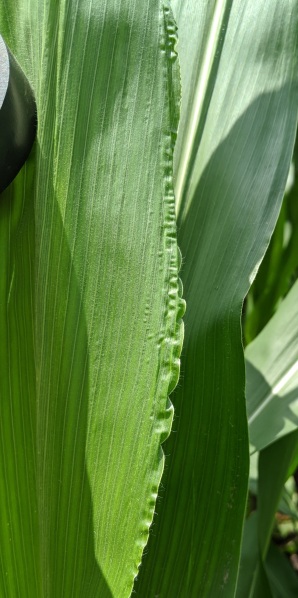| July-August Upcoming Events: July 20: CSI for youth in the field with Jenny, 5 p.m., RSVP jrees2@unl.edu Aug. 11: Soybean Management Field Days, Hildreth Aug. 12: Soybean Management Field Days, Elgin Aug. 13: Soybean Management Field Days, Shelby Aug. 14: Soybean Management Field Days, Arlington Aug. 20: Midwest Soil Health Clinic, ENREC Aug. 25: SCAL Field Day, Clay Center Aug. 26: Midwest Soybean Production Clinic, ENREC Aug. 27: Midwest Corn Production Clinic, ENREC |
Corn: Corn plants are rapidly growing and at or nearing tasseling soon. One sign of rapid growth is to look at the new leaf edges. Sometimes there will be a white margin, more transparent look, wrinkles, or notches in them. All of those are signs of rapid growth which take place during cell division.

Fertigation and Irrigation: Some fertilizer is occurring now before tassel. I also recommend 30 lbs of N at brown silk if needed. This is based on research from Purdue University sharing today’s hybrids use 30-40% of their total Nitrogen from flowering through maturity. In the past, some have asked about applying fertilizer during pollination. The following information is from Dr. Tom Hoegemeyer, Plant Breeder and UNL Professor of Practice Emeritus, “Pollination mostly occurs between 8:30 a.m. and Noon. Thus, as a precaution, I would not run a pivot on pollinating corn from 6 a.m. to Noon. When the temperature is 90°F to 95°F, the pollen is killed by heat and is seldom viable past 2 p.m. That leaves lots of time to run pivots, apply N, etc. when it won’t harm pollination. Silks tend to be viable for three or four days at these temperatures, so if a plant isn’t pollinated one day, generally the next day will work just fine. (If nitrogen is needed), I’d recommend that nitrogen go on as soon as practical. Corn nitrogen use is very high during the pre-tassel growth phase and again at kernel growth, from one to three weeks post pollination. About seven to ten days post pollination (before brown silk) lower N will start causing kernel abortion and serious yield loss in corn.” The UNL recommendation for fertigation is to use 30 lb of N with 0.25″ of water or 50-60 lb of N with 0.50″ of water.
Insects and Diseases: Thus far, insects and diseases have been pretty minimal in corn. Seeing some spidermites in low numbers. Japanese beetles are showing up in areas where they’ve traditionally been more of a problem. In corn, the threshold is 3 or more beetles per plant, clipping silks to ½” or less, with pollination less than 50% complete. The hard thing about the beetles is they have a long emergence of 3-4 weeks where they don’t all emerge at the same time…and they live as an adult for 3-4 weeks. The threshold for corn rootworm beetles for silk clipping is similar. Light trap data for western bean cutworm is showing moths are beginning to appear in low numbers. They prefer laying eggs on upper leaf surfaces of corn in late whorl stage to early tassel (however, I’ve seen them lay eggs on the underside of leaves and on leaves closer to developing ears in high heat). The current UNL economic threshold for treatment is 5-8% corn plants with eggs or larvae.

And, often there’s discussion about fungicide applications at tassel time or throwing in a fungicide with an insecticide (or vice versa) to save an application cost. I shared a great deal about this a few weeks ago; please be very careful with growth stages and what is applied in the tassel time. With uneven emergence, not all plants in the field will be tasseling at the same time, which allows for corn ear abnormalities when NIS in particular is added to the tank (or is in the product formulations) and applied just prior to tasseling. That’s why I prefer to see fungicide applications delayed to at least full brown silk and preferably later if there’s no disease pressure to warrant the application.

Research at UNL South Central Ag Lab showed we can still apply fungicide to dough stage with no yield difference, particularly in low disease pressure years. The research also didn’t show an automatic yield increase with tassel applications. This allows us to account for southern rust which has occurred at some point all but two years of my Extension career. With tight economics, it just makes more sense to me to delay fungicide applications to when disease warrants it vs. applying too early as some have had to repeat applications (when southern rust occurred after applying too early). It’s also just good resistance management to not apply when disease and insect pressure doesn’t warrant it. Also be aware that we can see corn leaf aphids flare after fungicide applications as the fungicide kills a natural fungus that keeps their numbers in check. Aphids also can interfere with pollination by covering tassels.
Soybeans: As soybeans approach R3 (beginning pod), that’s the critical time to avoid water stress in soybean (similar to tassel for corn). We recommend avoiding irrigating during flowering whenever possible to reduce disease pressure (such as white mold and SDS). Don’t pull insecticide triggers too early for soybean defoliators. UNL recommends 20% defoliation at reproductive stages from all defoliators.


































